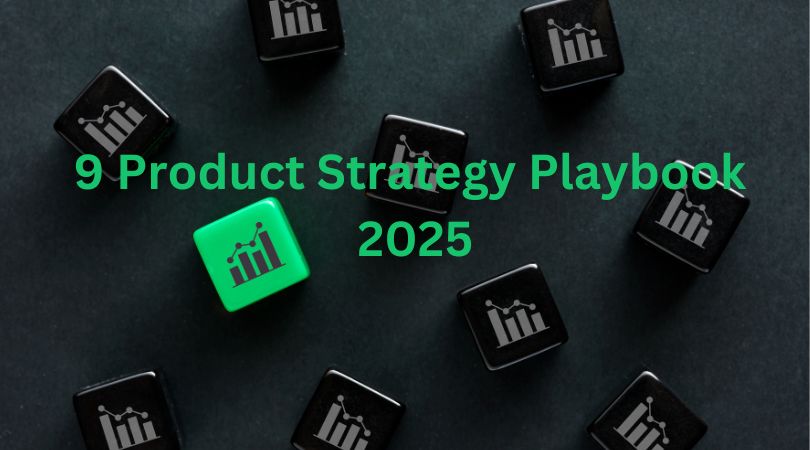The way companies develop product strategy and launching their products is changing fast. This year, most businesses might have to adjust their product strategies to remain in the game.
Right now, the customers have high expectations and the market is evolving. It’s not just about coming up with brilliant ideas anymore, it is more about making sure these ideas are words and it is constantly improved over time to keep the customers engaged.
To better understand what works, this playbook will guide you through some component needed to develop a winning product strategy that would work for the year 2025.
Wherher you’re just launching a startup or managing product that’s has already being launched, there key points will help me create something that will stand out among other strategies.
Understanding the 2025 Product Strategy Landscape

First, it is important to know that the product landscape in 2025 is shaped by a couple of trends.
- AI and automation are changing how products grow and get used. For instance, with artificial intelligence (AI) companies get creative and rethink products using big data and other analytical insights. Rather than spending hours thinking about words to use, AI can test different ideas in microseconds and recommend some ideas that work.
- Blockchain technology is making transactions more secure and transparent.
In 2025 businesses must think differently about their products; and their competitive strategy. Customers have higher expectations of creators, developers with technology which are constantly advancing.
Markets are constantly changing too. Having a good market plan and strategy is important for a strong product growth, but execution is just as important. You also need to be flexible and focus on customers’ needs.
This playbook will guide you through the key elements of a winning product strategy in 2025. Whether you’re launching a startup or managing an established product, these principles will help you create something that stands out and succeeds.
1. Understanding the 2025 Product Landscape
In 2025 product landscape is shaped by major trends:
- AI and automation change how products are created and how users relate to them.
- Blockchain adds security and transparency to transactions.
- Users have increasingly come to expect personalization.
- Flexible subscription and pay as you go pricing models are the norm now.
- Sustainability and ethical considerations now shape purchases.
Old product strategies are not enough anymore. Companies need to be quick, data driven and focused totally on customers.
2. Setting the Foundation: Defining Your Product Vision
A strong product vision shines like a beacon and serves as clear guidance. It asks essential questions:
- What problem are we trying to solve?
- Who is our main audience?
- How does our product enhance their lives?
The product vision must match our company’s bigger goals and be flexible enough to evolve alongside markets. Of all visions the best ones clearly speak out, inspiring people and setting a path for the team to focus on.
3. Market Research & Competitive Analysis
Building an outstanding product means having a deep understanding of your marketplace. This involves:
- Analyzing competition: What attributes do they excel about? Where are they placing mistakes?
- Hearing from customers: What’s the number one pain point for them?Using data and pattern discovery: What does the marketplace really require from you?
Conducting surveys and interviews as well as deep analysis will provide good insights. The better you understand those who need your product and your competitors, the better you will be at crafting your strategy.
4. Building a Customer-Centric Product Strategy
A great product is ultimately for the customer not the company. As of 2025 true top performers focus in their business on:
- User Research: Talk to real users to understand their needs
- Personalization: Ensure product can adapt to individual preferences
- Seamless Experience: Users should be able to get the best experience using your product. If customers don’t love using your product, they will find alternatives. Focus on solving their problems better than anyone else.
5. Agile Development & Iteration
The days of patiently engineering a new product for months or even years now belong in history. Agility reigns in 2025. the best practices are:
- Start with a Minimum Viable Product (MVP): Launch a basic version of your product quickly.
- Collect feedback early: Use beta testers and early adopters.
- Iterate continuously: Improve the product based on real user data.
Products that adapt and evolve win in the long run.
6. Pricing & Monetization Strategies
Your pricing model can make or break your product. In 2025, businesses are moving away from one-time payments and embracing more flexible pricing models:
- Subscription-based models: (monthly/yearly payments)
- Usage-based pricing: (pay for what you use)
- Freemium models: (basic free version, paid premium features)
The key is to balance affordability for customers with profitability for your business.
7. Go-to-Market (GTM) Strategy
An amazing product becomes worthless when no one knows about it. A great Go-To Market (GTM) strategy includes:
- Selling and Promotion: Communication strategies explaining how the product solves a problem
- Growth strategies: Social media, Search Engine Optimization (SEO), paid advertising, influencer advertising.
- Community-building: Connect with customers on credible social media channels.
In 2025, products with a stronger community are more successful, where people create a community around your brand and actively support and engage with it.
8. Measuring Success: KPIs & Metrics
What you cannot measure, you cannot improve. Some important Key Performance Indicators (KPIs) are:
- Customer Acquisition Cost (CAC): What is the cost of acquiring a new user?
- Customer Lifetime Value (LTV): What is the total amount of money a user spends over time?
- Retention Rate: How many users continue to return?
- Churn Rate: How many users discontinue utilizing the product?
- Engagement Metrics: Are people using the product?
The insights are invaluable. Over time, these help you create better products.
9. Future-Proofing Your Product Strategy
The market is always evolving. For companies to succeed in 2025 and beyond, they will need to:
- Be aware of emerging technologies (artificial intelligence, blockchain, internet of things, etc.)
- Be able to shift with the market demand
- Hear what their users say and make changes accordingly
- Create teams that are flexible and strong enough to change with the circumstances
There is no such thing as a “final” product strategy. The most successful teams continuously learn and enhance their processes.
Conclusion
The product world in 2025 is fast-moving and competitive. Companies that build great products focus on:
- Understanding market trends and customer needs
- Defining a strong, flexible product vision
- Using data to guide decision-making
- Adopting agile development and continuous iteration
- Building a loyal community of users
Success in product strategy is not just about building something great—it’s about adapting, improving, and staying ahead of the curve. Keep your focus on customers, embrace innovation, and your product will thrive in 2025 and beyond.
Read also: Helium (HNT): A new Revenue for Businesses?






